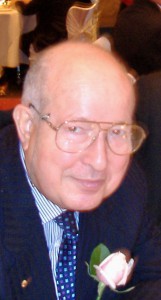Professor Alan Crown – a tribute
 Alan Crown (1932-2010) was one of Australian Jewry’s greatest intellectuals. He made contributions to Australian Jewish historiography, notably by means of extended monographs on Australian Zionism and the Jewish press, but his main fields of scholarly attainment lay elsewhere.
Alan Crown (1932-2010) was one of Australian Jewry’s greatest intellectuals. He made contributions to Australian Jewish historiography, notably by means of extended monographs on Australian Zionism and the Jewish press, but his main fields of scholarly attainment lay elsewhere.
Born and educated in Leeds, he served in the British army and had a stint as a schoolmaster in Britain and Australia, but once he joined the Semitic Studies department at Sydney University in 1962 he developed a reputation as a Hebraist and Bible scholar and in time became a world authority on Samaritan Studies and the Dead Sea Scrolls.
He might not have liked the comparison, but his Samaritan researches and writings could have earned him the encomium of the Book of Job (29:11):
Unto me men gave ear, and waited,
And kept silence for my counsel;
After my words they spake not again.
Alan’s judgment was sound, but he was no dictator. He appreciated the contributions and views of others, and indeed his encouragement of budding scholars was legendary.
His Dead Sea Scrolls work was partly academic, partly administrative. The Oxford Centre for Post-Graduate Hebrew and Jewish Studies, where he spent long periods of time including holding the acting presidency, knew that with him in charge of the Scrolls publication project there would be progress without constant inordinate delays.
As a teacher, professor and thesis supervisor he was admired and loved. A polymath whose knowledge ranged far afield, a communicator almost without peer, a concerned and generous mentor, he was to so many students the embodiment of the long running Reader’s Digest series, “My most unforgettable teacher”. Students learned to live with his coffee drinking and his quirky sense of humour; he could argue with a straight face for preposterous assertions such as “Biblical Israelites were all redheads” and “Lemuel” in the Book of Proverbs was the origin of the shlemiel’.
To me personally he was a wonderful colleague and department head. I taught in the department for over thirty years and felt flattered when he would sometimes say, “I will be away next week – will you take my classes for me?” It all meant much more work, but I could get my own back every now and then when he would substitute in my own classes, though I suspect it was child’s play to him whatever the subject.
Mandelbaum House at Sydney University was his idea. The benefactor, Rachel Lipton, was an early woman graduate who left most of her considerable estate to trustees, who included me as well as Alan, charging them to create a college in memory of her parents. It was amazing how Alan relished the role of dealing with architects, builders and local councils, and how he grasped the financial aspects of building up the estate and then expending the funds wisely. Once the college was open, he was there every day. He and I were joint Masters, though after I retired to Israel he did most of the work. He created Mandelbaum Publishing and knew every publication almost by heart.
He also initiated the establishment of the Archive of Australian Judaica at Fisher Library and appointed Sister Dr Marianne Dacy as the archivist. Her position continues to be supported by Mandelbaum Trust to the present day. Marianne has built a unique documentary collection relating to the history of Australian Jewry, which has been central to research on the community. She also completed her doctorate under Alan’s supervision on the separation of Judaism and Christianity.
He continued to research, write, advise, administer and encourage almost to his last day. Everyone who knew him was his friend. He and Sadie were a loving team and they enjoyed giving and receiving hospitality. Physically a short man, he was a giant in intellectual and personal stature. It is unbelievable that he has gone.
This tribute by Rabbi Raymond Apple appeared in the Journal of the Australian Jewish Historical Society, June 2011 (vol. XX, part 2).



